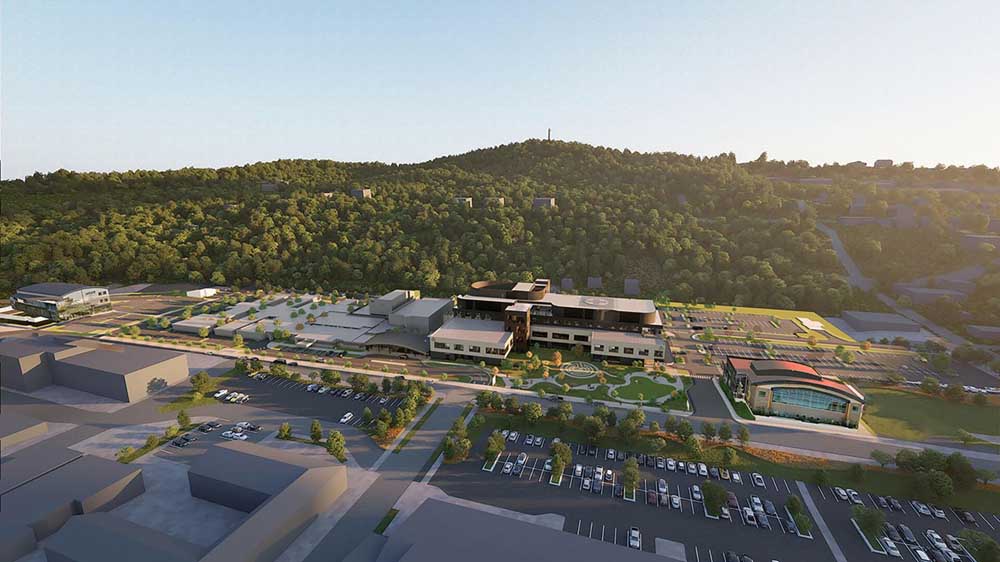Columbia Memorial Hospital finalizes design for expansion
Published 11:45 am Tuesday, January 23, 2024

- A rendering provides an aerial view of the Columbia Memorial Hospital expansion.
Columbia Memorial Hospital has finalized the design for an expansion and renovation project that will transform the campus on Exchange Street over the next several years.
The Astoria hospital unveiled details about the project last February and has since cleared development hurdles at the city. In December, the Astoria City Council approved a code amendment package exempting the project from design requirements under the city’s Gateway Overlay and allowing the project to bypass review by the city’s Historic Landmarks Commission.
Trending
Now, the project is moving toward an anticipated groundbreaking at the end of 2024, with some utility work beginning as early as June.
Hospital leadership met with The Astorian on Jan. 18 to outline the design, which is aimed at improving the patient experience at the 25-bed hospital and creating a resilient campus that can withstand extreme weather and natural disasters.
Construction is now estimated at between $225 million and $250 million — up from an initial estimate of $175 million. The new estimate does not include equipment costs, which are pending.
Erik Thorsen, Columbia Memorial’s chief executive, explained that a $20 million grant secured from the Federal Emergency Management Agency has been a significant development in the project.
The grant will allow for features such as a vertical evacuation tower and safe refuge space for up to 1,900 people on the hospital’s roof. Thorsen said the resiliency measures are intended to ensure the safety of hospital patients and staff while also providing refuge for anyone in the community during an earthquake or tsunami.
At about 750 employees, Columbia Memorial is among the largest employers in Clatsop County.
“We’re excited about that because we don’t know of another hospital up and down the Oregon Coast that has made this kind of investment in resiliency,” Thorsen said.
Patient spaces
The expansion involves restructured patient spaces designed to increase privacy and improve the flow of hospital operations. Hospital leadership worked closely with caregivers throughout the planning process to get feedback about what changes were most needed.
One advancement for privacy will be the installation of separate corridors for patients and staff. Thorsen explained that patients who come in for surgery now are wheeled down the main corridor of the hospital in view of staff and visitors.
“It’s not how we want to take care of our community … A lot of work has gone into having a patient flow and a private-public employee flow in the building,” he said.
The emergency department will also see changes, including an improved waiting area, additional patient rooms and expanded imaging options.
Dr. Christopher Strear, Columbia Memorial’s chief medical officer, said the hospital has outgrown the current space. The emergency department currently includes eight patient rooms, as well as a triage area that is frequently used as an additional patient room. The new facility will have 14 designated patient rooms with 24 treatment areas.
The expansion will also include a vertical care area for patients who do not need their own rooms — for example, those presenting with minor injuries after hours when urgent care clinics are closed. The design was based on feedback from caregivers and an analysis of frequent diagnoses in the emergency department.
“It was an iterative process that involved not just the people on the project management team and the architects and the leadership, but really, at every step, brought in the caregivers, the providers who were going to be living in that space,” Strear said. “And I can’t imagine we would have come up with anything even a fraction as great without that process.”
Another change is the installation of a new CT scanner and imaging equipment in the emergency department. Currently, when emergency patients require a CT scan or other imaging, they have to leave the emergency room and go to the hospital’s regular imaging department. With the additional scanner, the hospital can keep emergency patients close by and avoid having to divert stroke patients — who require urgent CT scans — to other hospitals.
“If something happens to that scanner, which happened this week during the ice storm, and it’s not available due to a maintenance or an equipment issue, then we have, really, no backup in the hospital,” Thorsen said. “So that causes us to go on stroke divert, which isn’t the best for our community … So hopefully we improve the patient experience and minimize the amount of time the hospital ever has to be on any type of divert status.”
Security
The emergency department will also include “safer rooms” designed for patients presenting in behavioral health crisis.
“It’s a way to provide care where the patient is kept comfortable, but also the patient is kept safe from self-harm or accidental harm on something that sticks out like a sink or sharp edges,” Strear said. “And also that helps keep the caregivers safe so that they can do what they need to do without having to worry about getting too close.”
Other safety enhancements include the installation of a 24/7 security presence in the emergency department and glass barriers in the reception area. These changes, Thorsen explained, were made in response to a shooting at a Portland hospital last summer.
“We actually did adjust the design of the emergency department entry and our entry into the facility based on that event in Portland … We tried again to do it in a manner that isn’t as intrusive, say, as a metal detector and a wall of glass,” Thorsen said. “(We are) trying to make it still an inviting entry but safe and secure for our caregivers and patients at the same time.”
Inpatient rooms — which will be housed on the third floor of the hospital to keep vulnerable patients safe in case of a tsunami — will also increase in size and feature technology upgrades.
Thorsen said the hospital hopes to complete phase one of the project — the construction of the new facility — by the end of 2026 or the beginning of 2027 before moving on to phase two, the demolition of the current hospital.






